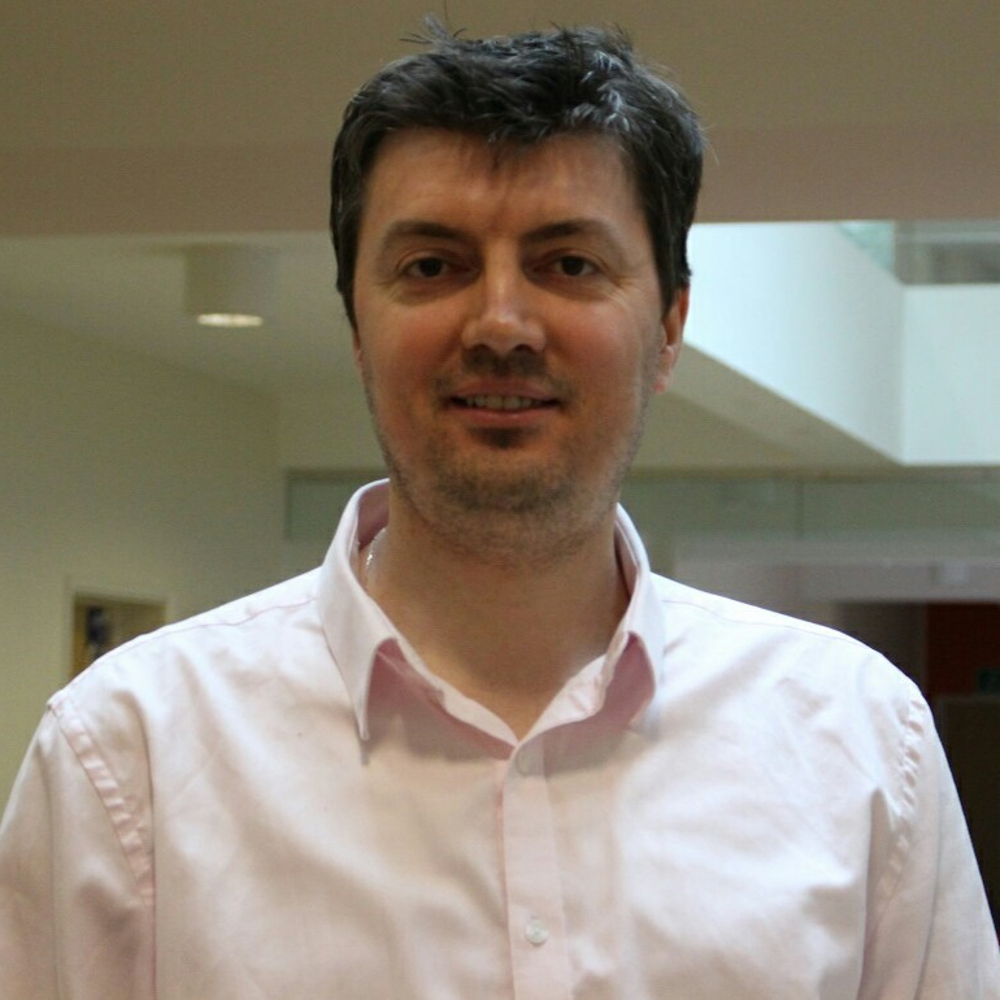Dr Chris Antonopoulos

-
Email
canton@essex.ac.uk -
Location
STEM 5.8, Colchester Campus
-
Academic support hours
You may contact me by email
Profile
Biography
My research focuses on using novel mathematical and computational techniques to study problems in dynamical systems, chaotic systems, computational neuroscience, complex systems and complex networks. In particular, one of my main interests is in computational neuroscience, and specifically in the development of approaches and mathematical tools that give insights into the inner workings of the brain. My current main focus is on studying the emergence of synchronisation phenomena in the brain using concepts from dynamical systems, nonlinear dynamics, chaos theory, information theory, complex systems and complex networks. The idea is to develop mathematical tools to analyse neural activity and collective behaviour in the brain in order to gain insights into its inner workings. This is primarily related to establishing the relationship between neural synchronisation and brain plasticity, as excessive bursting synchronisation in the plastic brain underpins brain disorders such as Parkinson’s and epilepsy. Another main focus of my work is on network inference using mathematical and information-theoretical approaches. The idea being the inference of the connectivity of the nodes in a network, when only access to recorded data on the nodes of the network (e.g. in the form of time-series) is available. The data may be experimental, may come from EEG studies, from coupled dynamical systems, or from other sources. Possible applications include brain functional connectivity, social networks, biological networks, etc. Related to these projects is my work on how synchronisation phenomena and chimera-like states, a peculiar synchronisation phenomenon observed in artificial systems, experiments and for example, in the brain of dolphins, macaque monkeys and birds, emerge in dynamical systems given by nonlinear systems of coupled ordinary differential equations. The main focus here is to develop mathematical approaches to better understand how synchronisation phenomena give rise to the emergence of collective behaviour in complex systems, such as the brain. This approach involves the study of the behaviour of individual components (microscopic analysis), all the way up to the study of the macroscopic behaviour attributed to the individual components of the system and to their connectivity. In parallel, I am working on the mathematical properties and long-term behaviour of dynamical systems given by nonlinear systems of coupled ordinary differential equations. These can be either dissipative or conservative, lower- or higher-dimensional. As these systems can rarely be solved analytically to obtain their solutions in closed form, this research involves the use of a combination of analytical and numerical approaches. I am interested in studying the structure of their state spaces and long-term dynamics. In doing so, I am using Lyapunov exponents, chaotic indicators (SALI, GALI, LDI, etc.), stability analysis of fixed points and periodic orbits, and bifurcation analysis, among other approaches. I am also working on ordered, weakly chaotic and chaotic dynamics in multi-dimensional Hamiltonian systems and on their connection to entropy and q-statistics, associated to non-extensive Statistical Mechanics. The focus here is on studying how energy spreads in Hamiltonian lattices, representing chains of particles, in various regimes and whether it equilibrates in the thermodynamic limit, a long-debated question in the field. The work in the project is supported by techniques such as Lyapunov spectra, chaotic indicators (SALI, GALI, LDI, etc.), stability analysis of fixed points and periodic orbits, and bifurcation analysis. This research also involves the use of a combination of analytical and numerical approaches, involving but not limited to symplectic integrators. I have developed an interest in studying mathematically the spread of COVID-19 in communities, for example, in countries, states, etc., modelling published data using for example, the SIR and extended versions of the SIR models. The project focuses on forecasting reliably the spread of the disease, including the possibility of surges in the susceptible population. This involves studying different approaches and scenarios to confine the spread and eventually halt it, contributing thus to the well-being of communities and individuals. I am interested in time-series analysis and forecasting, techniques that utilise historical and current data to understand and predict future values over a period of time or a specific point in the future. By analysing data stored in the past, we can make informed decisions that can guide, for example business strategies and help understand future trends. I am also very much interested in using machine learning and artificial intelligence techniques in pushing the boundaries of my research, for example in network inference, predictability in chaotic dynamics and time-series analysis and forecasting. The truly interdisciplinary nature of my research means that I work with a range of collaborators from different fields and backgrounds. I believe in the value of communicating scientific research, and in the role that mathematics and quantitative approaches can play in my research. To this end, I have organised a range of mini-symposia, have presented my work as invited speaker in international conferences, have become editor in peer-reviewed journals and have delivered high-profile public engagement talks. I am an elected Member of the Institute of Mathematics and its Applications (MIMA), and member of the London Mathematical Society (LMS). I am also a Fellow of the Higher Education Academy (FHEA). Please do contact me if you are interested in any of those subjects, including applications of machine learning and artificial intelligence techniques and time-series analysis and forecasting.
Qualifications
-
BSc in Mathematics University of Crete, (1999)
-
MSc in Dynamical Systems and Differential Equations University of Patras, (2002)
-
PhD (thesis: "Stability and chaos in Hamiltonian systems of many degrees of freedom: From classical to statistical mechanics") University of Patras, (2007)
Appointments
University of Essex
-
Lecturer in Applied Mathematics, Department of Mathematical Sciences, University of Essex (15/9/2015 - present)
Other academic
-
Research Fellow (EPSRC), Department of Physics (ICSMB), University of Aberdeen (12/10/2012 - 31/8/2015)
-
Post Doctoral Researcher, Department of Mathematics, University of Patras (1/9/2010 - 31/12/2012)
-
Post Doctoral Researcher, Service de Physique des Systèmes Complexes et Mécanique Statistique, Université Libre de Bruxelles (1/10/2008 - 30/9/2010)
Research and professional activities
Research interests
Mathematical modelling of the brain
In this project, I am interested in modelling and studying the brain mathematically, combining concepts from dynamical systems, chaos theory, nonlinear dynamics, complex networks, complex systems and synchronisation theory. I am fascinated by its inner workings and am developing mathematical approaches to study and better understand. Prospective PhD students who want to work on the project, are welcome to contact me for further details.
Mathematical approaches to infer network connectivity
In this project, I am working on network inference using mathematical and information-theoretical approaches. We want to infer the connectivity of the nodes in a network, when we only have access to recorded data on the nodes of the network (e.g. in the form of time-series). The data may be experimental, may come from EEG studies, from coupled dynamical systems, or from other sources. Possible applications include brain functional connectivity, social networks, biological networks, etc. Prospective PhD students who want to work on the project, are welcome to contact me for further details.
Multi-dimensional Hamiltonian systems, chaotic dynamics and complex statistics
In this project, I am studying, ordered, weakly chaotic and chaotic dynamics in multi-dimensional Hamiltonian systems and their connection to entropy and q-statistics, associated to non-extensive Statistical Mechanics. We want to understand how energy spreads in Hamiltonian lattices, representing chains of particles, in various regimes and whether it equilibrates in the thermodynamic limit, a long-debated question in the field. Techniques used are Lyapunov spectra, chaotic indicators (SALI, GALI, LDI, etc.), stability analysis of fixed points and periodic orbits, and bifurcation analysis, among other approaches. This research also involves the use of a combination of analytical and numerical approaches, involving but not limited to symplectic integrators. Prospective PhD students who want to work on the project, are welcome to contact me for further details.
Mathematical modelling of the spread of COVID-19 in communities
In this project, I am conducting fascinating research on the spread of COVID-19 in communities (for example, in countries, states, etc.), modelling published data using for example, the SIR and extended versions of the SIR models. We want to forecast reliably the spread of the disease, including the possibility of surges in the susceptible population. We aim to studying different approaches and scenarios to confine the spread and eventually halt it, contributing thus to the well-being of communities and individuals. Prospective PhD students who want to work on the project, are welcome to contact me for further details.
Nonlinear dynamics and long-term behaviour
In this project, I am studying the mathematical properties and long-term behaviour of dynamical systems given by nonlinear systems of coupled ordinary differential equations. These can be either dissipative or conservative, lower- or higher-dimensional. As these systems can rarely be solved analytically to obtain their solutions in closed form, this research involves the use of a combination of analytical and numerical approaches, involving but not limited to numerical integrators. I am interested in studying the structure of their state spaces and long-term dynamics. Techniques used are Lyapunov spectra, chaotic indicators (SALI, GALI, LDI, etc.), stability analysis of fixed points and periodic orbits, and bifurcation analysis, among other approaches. Prospective PhD students who want to work on the project, are welcome to contact me for further details.
Synchronisation, chimera-like states and emergence of collective behaviour in complex systems
In this project, I am conducting fascinating research on how synchronisation phenomena and chimera-like states, a peculiar synchronisation phenomenon observed in artificial systems, experiments and for example, in the brain of dolphins, macaque monkeys and birds, emerge in dynamical systems given by nonlinear systems of coupled ordinary differential equations. My goal is to develop mathematical approaches to better understand how synchronisation phenomena give rise to the emergence of collective behaviour in complex systems, such as the brain. This approach involves the study of the behaviour of individual components (microscopic analysis), all the way up to the study of the macroscopic behaviour attributed to the individual components of the system and to their connectivity. Prospective PhD students who want to work on the project, are welcome to contact me for further details.
Time-series analysis and forecasting
I am happy to supervise PhD projects on time-series analysis and time-series forecasting, in conjunction with machine learning and artificial intelligence approaches.
Any of the PhD projects I am offering, combined with machine learning and/or artificial intelligence approaches
I am happy to supervise PhD projects in the interface between any of those in my research interests, and machine learning/artificial intelligence. Start Date 12 Oct 2023
Conferences and presentations
Mathematical Modelling of the Brain
Invited presentation, AMMS 2023, Leipzig, Germany, 16/7/2023
Network Inference Combining Mutual Information Rate and Statistical Tests
Invited presentation, Centre for Social and Economic Network Analysis (SENA), 22/3/2023
Mathematical Modelling of the Brain and Pandemics: Can we Predict the Future Behaviour of a System?
Invited presentation, Mexico City, Mexico, 25/2/2023
Can we Predict the Future Behaviour of a System?
Keynote presentation, Mathematics, Informatics, Science, and Education International Conference (MISEIC) 2022, 10/9/2022
Chaos Theory: Past, Present, Future
Invited presentation, International Virtual Courses: Summer School on Future Mathematics and its Applications, 26/7/2021
Hamiltonian Systems of Many Degrees of Freedom: From Classical to Statistical Mechanics
Invited presentation, 27th Summer School in Dynamical Systems and Complexity, 21/7/2021
Chimera-like Synchronisation Phenomena in the Brain
Invited presentation, Dynamics Days Central Asia (DDCA VI), 3/6/2020
Network Inference Based on Mutual Information Rate
Invited presentation, NCSR “Demokritos”, 19/2/2020
Modelling the Brain: From Dynamical Complexity to Neural Synchronisation, Chimera- like States and Information Flow Capacity
Invited presentation, 6th PhD School/Conference on Mathematical Modeling of Complex Systems, 10/7/2019
Modelling the Brain: From Dynamical Complexity to Neural Synchronisation, Chimera-like States and Information Flow Capacity
Invited presentation, BAMC 2019, 25/4/2019
Modelling the Brain: From Dynamical Complexity to Neural Synchronisation, Chimera-like States and Information Flow Capacity
Invited presentation, CHAOS2018, 6/6/2018
Modelling the Brain: From Dynamical Complexity to Neural Synchronisation, Chimera-like States and Information Flow Capacity
Invited presentation, CHAOS 2017, 30/5/2017
Teaching and supervision
Current teaching responsibilities
-
Mathematics Careers and Employability (MA199)
-
Advanced Ordinary Differential Equations and Dynamical Systems (MA307)
Current supervision
Previous supervision

Degree subject: Applied Mathematics
Degree type: Doctor of Philosophy
Awarded date: 2/10/2024

Degree subject: Applied Mathematics
Degree type: Doctor of Philosophy
Awarded date: 15/3/2024

Degree subject: Applied Mathematics
Degree type: Doctor of Philosophy
Awarded date: 6/7/2020

Degree type: Master of Science
Awarded date: 5/10/2016
Publications
Journal articles (60)
Christodoulidi, H. and Antonopoulos, CG., (2025). Energy localisation and dynamics of a mean-field model with non-linear dispersion. Physica D : Non-linear phenomena. 471, 134432-134432
Chakraborty, C., Saha, N., Aziz-Alaoui, MA., Mondal, A., Antonopoulos, C. and Zemskov, EP., (2025). A piecewise-linear adaptive exponential integrate-and-fire neuron model with emerging traveling waves using analytical scheme. Nonlinear Dynamics
Schickhofer, L. and Antonopoulos, CG., (2024). Cause–effect relationship between model parameters and damping performance of hydraulic shock absorbers. International Journal of Non-Linear Mechanics. 159, 104627-104627
Yildirim, H. and Antonopoulos, CG., (2024). Network inference using mutual information rate, statistical tests and amplitude-phase modulated surrogate data. Chaos, Solitons and Fractals. 188, 115554-115554
Zulkarnain, Z., Susanto, H. and Antonopoulos, CG., (2024). Disordered FPUT-α Hamiltonian Lattices: recurrence breakdown and chaotic behavior. Chaos, Solitons and Fractals. 189 (1), 115570-115570
Sharma, SK., Mondal, A., Kaslik, E., Hens, C. and Antonopoulos, CG., (2023). Diverse electrical responses in a network of fractional-order conductance-based excitable Morris-Lecar systems. Scientific Reports. 13 (1), 8215-
Schickhofer, L. and Antonopoulos, CG., (2023). Nonlinear dynamics and onset of chaos in a physical model of a damper pressure relief valve. Communications in Nonlinear Science and Numerical Simulation. 125, 107378-107378
Antonopoulos, CG., (2023). Network inference combining mutual information rate and statistical tests. Communications in Nonlinear Science and Numerical Simulation. 116, 106896-106896
Cooper, I., Mondal, A., Antonopoulos, CG. and Mishra, A., (2022). Dynamical analysis of the infection status in diverse communities due to COVID-19 using a modified SIR model. Nonlinear Dynamics. 109 (1), 19-32
Rodríguez-Méndez, DA., San-Juan, D., Hallett, M., Antonopoulos, CG., López- Reynoso, E. and Lara-Ramírez, R., (2022). A new model for freedom of movement using connectomic analysis. PeerJ. 10, e13602-e13602
Zulkarnain, Susanto, H. and Antonopoulos, CG., (2022). Energy-recurrence Breakdown and Chaos in Disordered Fermi-Pasta-Ulam- Tsingou Lattices. Chaos, Solitons and Fractals. 165 (1), 112850-112850
Mondal, A., Mondal, A., Aziz-Alaoui, MA., Upadhyay, RK., Sharma, SK. and Antonopoulos, CG., (2022). The generation of diverse traveling pulses and its solution scheme in an excitable slow-fast dynamics. Chaos: an interdisciplinary journal of nonlinear science. 32 (8), 083121-
Antonopoulos, CG., Akrami, MH., Basios, V. and Latifi, A., (2022). A generic model for pandemics in networks of communities and the role of vaccination. Chaos: an interdisciplinary journal of nonlinear science. 32 (6), 063127-
Mondal, A., Hens, C., Mondal, A. and Antonopoulos, CG., (2021). Spatiotemporal instabilities and pattern formation in systems of diffusively coupled Izhikevich neurons. Chaos, Solitons and Fractals. 152, 111375-111375
Mondal, A., Mondal, A., Kumar Sharma, S., Kumar Upadhyay, R. and Antonopoulos, CG., (2021). Spatiotemporal characteristics in systems of diffusively coupled excitable slow-fast FitzHugh-Rinzel dynamical neurons. Chaos: an interdisciplinary journal of nonlinear science. 31 (10), 103122-
Lameu, EL., Borges, FS., Iarosz, KC., Protachevicz, PR., Antonopoulos, CG., Macau, EEN. and Batista, AM., (2021). Short-term and spike-timing-dependent plasticity facilitate the formation of modular neural networks. Communications in Nonlinear Science and Numerical Simulation. 96, 105689-105689
Borges, FS., Protachevicz, PR., Pena, RFO., Lameu, EL., Higa, GSV., Kihara, AH., Matias, FS., Antonopoulos, CG., de Pasqual, R., Roque, AC., Iarosz, KC., Ji, P. and Batista, AM., (2020). Self-sustained activity of low firing rate in balanced networks. Physica A: Statistical Mechanics and its Applications. 537, 122671-122671
Cooper, I., Mondal, A. and Antonopoulos, CG., (2020). A SIR model assumption for the spread of COVID-19 in different communities. Chaos, Solitons and Fractals. 139, 110057-110057
Ghosh, S., Mondal, A., Ji, P., Mishra, A., Kumar Dana, S., Antonopoulos, CG. and Hens, C., (2020). Emergence of mixed mode oscillations in random networks of diverse excitable neurons: the role of neighbors and electrical coupling. Frontiers in Computational Neuroscience. 14, 1-11
Cooper, I., Mondal, A. and Antonopoulos, CG., (2020). Dynamic tracking with model-based forecasting for the spread of the COVID-19 pandemic. Chaos, Solitons and Fractals. 139, 110298-110298
Basios, V., Antonopoulos, CG. and Latifi, A., (2020). Labyrinth chaos: Revisiting the elegant, chaotic, and hyperchaotic walks. Chaos: an interdisciplinary journal of nonlinear science. 30 (11), 113129-
Protachevicz, PR., Iarosz, KC., Caldas, IL., Antonopoulos, CG., Batista, AM. and Kurths, J., (2020). Influence of autapses on synchronisation in neural networks with chemical synapses. Frontiers in Systems Neuroscience. 14, 604563-
Protachevicz, PR., Santos, MS., Seifert, EG., Gabrick, EC., Borges, FS., Borges, RR., Trobia, J., Szezech Jr, JD., Iarosz, KC., Caldas, IL., Antonopoulos, CG., Xu, Y., Viana, RL. and Batista, AM., (2020). Noise induces continuous and noncontinuous transitions in neuronal interspike intervals range. Pramana: journal of physics
Protachevicz, PR., da Silva Borges, F., Lameu, EL., Ji, P., Iarosz, KC., Kihara, AH., Caldas, IL., Szezech, JD., Baptista, MS., Macau, EEN., Antonopoulos, CG., Batista, AM. and Kurths, J., (2019). Bistable firing pattern in a neural network model. Frontiers in Computational Neuroscience. 13 (19), 19-
Basios, V. and Antonopoulos, CG., (2019). Hyperchaos & labyrinth chaos: Revisiting Thomas–Rössler systems. Journal of Theoretical Biology. 460, 153-159
Antonopoulos, CG., Martinez-Bianco, E. and Baptista, M., (2019). Evaluating performance of neural codes in model neural communication networks. Neural Networks. 109, 90-102
Antonopoulos, CG. and Shang, Y., (2018). Opinion formation in multiplex networks with general initial distributions. Scientific Reports. 8 (1), 2852-
Goh, YK., Hasim, HM. and Antonopoulos, CG., (2018). Inference of financial networks using the normalised mutual information rate. PLoS ONE. 13 (2), e0192160-e0192160
Antonopoulos, CG., Martinez, EB. and Baptista, MS., (2018). Evaluating performance of neural codes in neural communication networks
Antonopoulos, CG., Skokos, C., Bountis, T. and Flach, S., (2017). Analyzing chaos in higher order disordered quartic-sextic Klein-Gordon lattices using q-statistics. Chaos, Solitons and Fractals. 104, 129-134
Antonopoulos, CG. and Baptista, MS., (2017). Maintaining extensivity in evolutionary multiplex networks. PLoS ONE. 12 (4), e0175389-e0175389
Borges, RR., Borges, FS., Lameu, EL., Batista, AM., Iarosz, KC., Caldas, IL., Antonopoulos, CG. and Baptista, MS., (2017). Spike timing-dependent plasticity induces non-trivial topology in the brain.. Neural Networks. 88, 58-64
Antonopoulos, CG., Bountis, T. and Drossos, L., (2016). Coupled symplectic maps as models for subdiffusive processes in disordered Hamiltonian lattices. Applied Numerical Mathematics. 104, 110-119
Hizanidis, J., Kouvaris, NE., Zamora-López,, G., Díaz-Guilera, A. and Antonopoulos, CG., (2016). Chimera-like states in modular neural networks. Scientific Reports. 6 (1), 19845-
Antonopoulos, CG., (2016). Dynamic range in the C.elegans brain network. Chaos. 26 (1), 013102-
Bianco-Martinez, E., Rubido, N., Antonopoulos, CG. and Baptista, MS., (2016). Successful network inference from time-series data using Mutual Information Rate. Chaos. 26 (4), 043102-
Antonopoulos, CG., Fokas, AS. and Bountis, TC., (2016). Dynamical complexity in the C.elegans neural network. European Physical Journal Special Topics. 225 (6-7), 1255-1269
Antonopoulos, CG., Srivastava, S., Pinto, SEDS. and Baptista, MS., (2015). Do brain networks evolve by maximizing their information flow capacity?. PLoS Computational Biology. 11 (8), e1004372-e1004372
Hizanidis, J., Kouvaris, NE. and Antonopoulos, CG., (2015). Metastable and chimera-like states in the C.elegans brain network. Cybernetics and Physics. 4 (1), 17-20
Antonopoulos, CG., Michas, G., Vallianatos, F. and Bountis, T., (2014). Evidence of q-exponential statistics in Greek seismicity. Physica A Statistical Mechanics and Its Applications. 409, 71-77
Antonopoulos, CG., Bianco-Martinez, E. and Baptista, MS., (2014). Production and transfer of energy and information in Hamiltonian systems. PLoS ONE. 9 (2), e89585-e89585
Antonopoulos, CG., Bountis, T., Skokos, C. and Drossos, L., (2014). Complex statistics and diffusion in nonlinear disordered particle chains.. Chaos: an interdisciplinary journal of nonlinear science. 24 (2), 024405-
Antonopoulos, C., Basios, V., Demongeot, J., Nardone, P. and Thomas, R., (2013). Linear and nonlinear arabesques: A study of closed chains of negative 2-element circuits. International Journal of Bifurcation and Chaos. 23 (9), 1330033-1330033
Manos, T., Skokos, C. and Antonopoulos, C., (2012). Probing the local dynamics of periodic orbits by the Generalized Alignment Index (GALI) method. International Journal of Bifurcation and Chaos. 22 (09), 1250218-1250218
Bountis, T., Manos, T. and Antonopoulos, C., (2012). Complex statistics in Hamiltonian barred galaxy models. Celestial Mechanics and Dynamical Astronomy. 113 (1), 63-80
Antonopoulos, C. and Christodoulidi, H., (2011). Weak chaos detection in the Fermi–Pasta–Ulam-α system using q-Gaussian statistics. International Journal of Bifurcation and Chaos. 21 (08), 2285-2296
Antonopoulos, C., Bountis, T. and Basios, V., (2011). Quasi-stationary chaotic states in multi-dimensional Hamiltonian systems. Physica A Statistical Mechanics and Its Applications. 390 (20), 3290-3307
García Cantú Ros, A., Antonopoulos, CG. and Basios, V., (2011). Emergence of coherent motion in aggregates of motile coupled maps. Chaos Solitons and Fractals. 44 (8), 574-586
Antonopoulos, C., Basios, V. and Bountis, T., (2010). Weak chaos and the “melting transition” in a confined microplasma system. Physical Review E. 81 (1), 016211-
Petalas, YG., Antonopoulos, CG., Bountis, TC. and Vrahatis, MN., (2009). Detecting resonances in conservative maps using evolutionary algorithms. Physics Letters Section A General Atomic and Solid State Physics. 373 (3), 334-341
Petalas, YG., Antonopoulos, CG., Bountis, TC. and Vrahatis, MN., (2008). Evolutionary methods for the approximation of the stability domain and frequency optimization of conservative maps. International Journal of Bifurcation and Chaos. 18 (8), 2249-2264
Skokos, C., Bountis, T. and Antonopoulos, C., (2008). Detecting chaos, determining the dimensions of tori and predicting slow diffusion in Fermi–Pasta–Ulam lattices by the Generalized Alignment Index method. The European Physical Journal Special Topics. 165 (1), 5-14
Skokos, C., Bountis, TC. and Antonopoulos, C., (2007). Geometrical properties of local dynamics in Hamiltonian systems: The Generalized Alignment Index (GALI) method. Physica D Nonlinear Phenomena. 231 (1), 30-54
Antonopoulos, C., Bountis, T. and Skokos, C., (2006). Chaotic dynamics of N-degree of freedom Hamiltonian systems. International Journal of Bifurcation and Chaos. 16 (06), 1777-1793
Antonopoulos, C. and Bountis, T., (2006). Detecting order and chaos by the Linear Dependence Index (LDI) method. ROMAI Journal. 2 (2), 1-13
Petalas, YG., Antonopoulos, C., Bountis, T. and Vrahatis, MN., (2006). Detecting resonances using evolutionary algorithms. Recent Progress in Computational Sciences and Engineering. 7A-B, 443-443
Antonopoulos, C. and Bountis, T., (2006). Stability of simple periodic orbits and chaos in a Fermi-Pasta-Ulam lattice. Physical Review E Statistical Nonlinear and Soft Matter Physics. 73 (5), 056206-
Skokos, C., Antonopoulos, C., Bountis, TC. and Vrahatis, MN., (2004). Detecting order and chaos in Hamiltonian systems by the SALI method. Journal of Physics A Mathematical and General. 37 (24), 6269-6284
Skokos, C., Antonopoulos, C., Bountis, TC. and Vrahatis, M., (2003). How does the Smaller Alignment Index (SALI) distinguish order from chaos?. Progress of Theoretical Physics Supplement. 150 (150), 439-443
Rothos, VM., Antonopoulos, C. and Drossos, L., (2002). Chaos in a near-integrable Hamiltonian lattice. International Journal of Bifurcation and Chaos in Applied Sciences and Engineering. 12 (8), 1743-1754
Book chapters (2)
Christodoulidi, H., Van Der Weele, K., Antonopoulos, CG. and Bountis, T., (2014). Phase transitions in models of bird flocking. In: Chaos, Information Processing and Paradoxical Games: The Legacy of John S. Nicolis. Editors: Nicolis, G., . World Scientific. 383- 398. 978-981-4602-14-3
Antonopoulos, C., Skokos, C., Bountis, T. and Vrahatis, MN., (2003). A fast and reliable method for distinguishing regular from chaotic motion in Hamiltonian systems. In: Recent Advances in Mechanics and Related Fields. University of Patras. 325- 333
Conferences (7)
Provata, A., Antonopoulos, CG. and Vlamos, P., (2022). Controlling the chimera form in the Leaky Integrate-and-Fire model
Sigalas, E., Li, J., Bezerianos, A. and Antonopoulos, CG., (2018). Emergence of chimera-like states in prefrontal-cortex macaque intracranial recordings
Petalas, YG., Antonopoulos, C., Bountis, T. and Vrahatis, MN., (2007). Ανίχνευση συντονισμών σε διατηρητικές απεικονίσεις με τη χρήση εξελικτικών αλγορίθμων (Detecting resonances in conservative maps using evolutionary algorithms)
Antonopoulos, C., Petelas, YG., Bountis, T. and Vrahatis, MN., (2005). Υπολογισμός της δυναμικής ακτίνας ευστάθειας συμπλεκτικών απεικονίσεων με χρήση εξελικτικών αλγορίθμων (Calculation of the dynamic aperture of stability of symplectic maps using evolutionary algorithms)
Antonopoulos, C., Manos, T. and Skokos, C., (2004). SALI: An efficient indicator of chaos with application to 2 and 3 degrees of freedom Hamiltonian systems
Skokos, C., Antonopoulos, C., Bountis, TC. and Vrahatis, MN., (2003). Smaller Alignment Index (SALI): Determining the ordered or chaotic nature of orbits in conservative dynamical systems
Skokos, C., Antonopoulos, C., Bountis, TC. and Vrahatis, MN., (2002). Smaller Alignment Index (SALI): Detecting order and chaos in conservative dynamical systems
Other (3)
Manos, T., Antonopoulos, CG., Batista, A. and Iarosz, K., (2024).Editorial: Advancing our understanding of the impact of dynamics at different spatiotemporal scales and structure on brain synchronous activity, volume II. Frontiers in Computational Neuroscience. 18,Frontiers Media
Manos, T., Antonopoulos, CG., Batista, AM. and Iarosz, KC., (2022).Editorial: Advancing our understanding of the impact of dynamics at different spatiotemporal scales and structure on brain synchronous activity. Frontiers in Network Physiology. 2,Frontiers Media SA
Antonopoulos, CG., Rubido, N., Batista, A. and Baptista, M., (2021).Editorial: Advancing our understanding of structure and function in the brain: Developing novel approaches for network inference and emergent phenomena. Frontiers in Physics. 8,Frontiers Media
Grants and funding
2025
RESEARCH IN PAIRS MAY 2025 - Prof. Jes�s M. Seoane's Visit
London Mathematical Society
2024
Climbing Trees KTP
Innovate UK (formerly Technology Strategy Board)
2023
Daedalus Fractal Biomarker and Experimental Longitudinal Study
Verenigma Ltd
2022
Understanding the nonlinear dynamics and onset of chaos within modern hydraulic shock absorbers
European Commission
Using mathematical modelling to better understand neural dynamical networks attributed to brain functioning
London Mathematical Society
2020
Modelling brain activity: reconciling empirical imaging data with network inference and dynamics with an outlook on Alzheimers's disease
Institut Henri Poincare, France
2019
Studying the emergence of chimera states and self-organisation in dynamical networks
London Mathematical Society
Synchronous behaviour in stochastic neuronal networks (CONFAP - THE UK ACADEMIES 2018)
National Council for Scientific and Technological Development, Brazil
Contact
Academic support hours:
You may contact me by email
Follow me on social media




